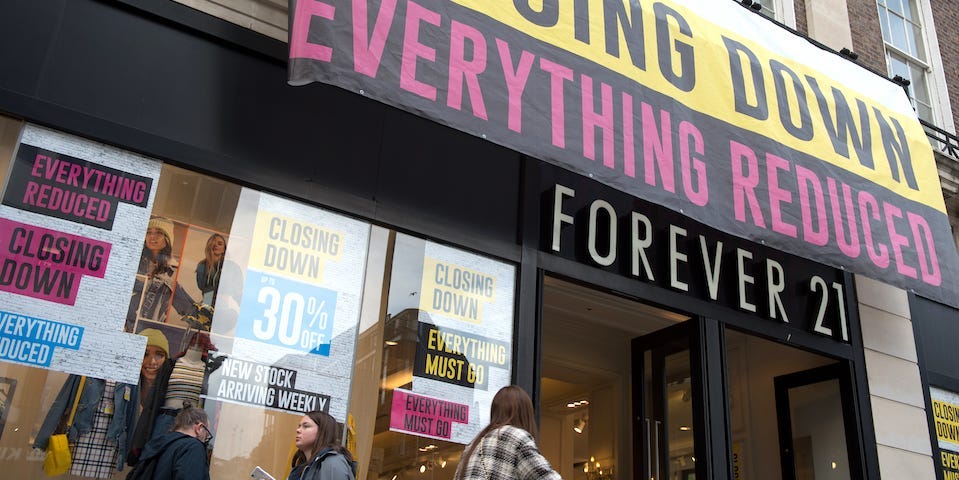From Trendsetter to Bankruptcy: The Dramatic Saga of Forever 21
Business
2025-03-18 16:29:23Content

In the dynamic world of fast fashion, Forever 21 emerged as a pioneering force, setting the stage for a new generation of budget-friendly, trend-driven clothing brands. At the height of its success, the retailer was a global phenomenon, rapidly expanding its footprint and influencing the way young consumers approached fashion.
The brand's meteoric rise paved the way for contemporary online fashion giants like Temu and Shein, who have since adopted and amplified Forever 21's core business model. By offering trendy, affordable clothing at lightning-fast production speeds, Forever 21 demonstrated that style didn't have to come with a hefty price tag.
From its humble beginnings in Los Angeles to becoming a worldwide retail sensation, Forever 21 revolutionized the fashion industry by making current runway-inspired looks accessible to budget-conscious shoppers. Its innovative approach to quick turnaround and affordable pricing became a blueprint that subsequent online fashion retailers would eagerly follow.
Today, while Forever 21 has faced significant challenges, its legacy continues to resonate through the digital fashion landscape, inspiring a new wave of global, internet-driven clothing brands that prioritize speed, affordability, and trend responsiveness.
The Rise and Fall of Forever 21: A Fashion Empire's Turbulent Journey
In the dynamic world of fast fashion, few stories are as compelling as the meteoric rise and dramatic transformation of Forever 21, a retail phenomenon that reshaped the global fashion landscape and paved the way for a new generation of budget-friendly clothing brands.From Humble Beginnings to Global Fashion Disruptors
The Entrepreneurial Genesis of Forever 21
Forever 21's narrative begins with a quintessential immigrant success story that epitomizes the American dream. Do Won Chang and his wife Jin Sook, Korean immigrants who arrived in the United States with minimal resources, transformed their modest dreams into a retail powerhouse. Starting with a single 900-square-foot store in Los Angeles in 1984, they initially named their business Fashion 21, targeting the local Korean-American community. Their initial strategy was revolutionary: offer trendy, affordable clothing that mimicked high-end designer styles at a fraction of the cost. This approach resonated deeply with young consumers who craved fashionable attire without breaking the bank. The store's rapid expansion reflected a profound understanding of consumer psychology and emerging fashion trends.Pioneering the Fast Fashion Model
Forever 21 emerged as a trailblazer in the fast fashion ecosystem, developing an unprecedented supply chain that could rapidly translate runway trends into affordable retail products. Their business model was predicated on swift design replication, efficient manufacturing, and lightning-fast distribution networks. The company's ability to quickly produce trendy clothing at incredibly competitive prices disrupted traditional fashion retail models. By maintaining minimal inventory and constantly refreshing product lines, Forever 21 created a shopping experience that felt perpetually exciting and dynamic.Global Expansion and Cultural Impact
As the brand expanded internationally, it became more than just a clothing retailer—it transformed into a cultural phenomenon. Forever 21 stores became destinations for teenagers and young adults seeking affordable, trend-forward fashion. Their marketing strategies targeted younger demographics with precision, leveraging social media and influencer partnerships long before such approaches became industry standard. The brand's international footprint grew exponentially, with stores spanning continents and capturing market share in diverse economic landscapes. From shopping malls in the United States to bustling urban centers in Asia, Forever 21 became synonymous with accessible fashion.The Technological and Operational Revolution
Forever 21's operational model became a blueprint for subsequent digital-first fashion brands like Shein and Temu. They were among the first traditional retailers to recognize the transformative potential of e-commerce, investing heavily in digital infrastructure and online shopping experiences. Their technological innovations included sophisticated inventory management systems, real-time trend tracking algorithms, and data-driven design processes. These technological investments allowed them to remain agile in an increasingly competitive market, predicting and responding to consumer preferences with remarkable accuracy.Challenges and Transformation
Despite their initial success, Forever 21 faced significant challenges. Rapid expansion, increased competition, and changing consumer preferences led to financial difficulties. The company filed for bankruptcy in 2019, marking a dramatic turning point in their corporate narrative. However, their legacy extends far beyond their financial struggles. Forever 21 fundamentally reshaped consumer expectations around fashion accessibility, pricing, and trend responsiveness. They demonstrated that fashion could be democratized, making style available to broader demographic segments.The Lasting Legacy of a Fashion Disruptor
Today, Forever 21's DNA can be seen in numerous contemporary fashion brands. Their innovative approach to fast fashion continues to influence retail strategies worldwide, proving that their impact transcends their own corporate trajectory. The brand's journey illustrates the volatile nature of retail, the importance of adaptability, and the potential for immigrant entrepreneurs to reshape entire industries through vision, hard work, and strategic innovation.RELATED NEWS
Business

Tariff Tsunami: Business Owner Warns of Imminent Collapse Under Trump's China Trade War
2025-04-11 18:23:14
Business

Breaking Barriers: Women Entrepreneurs Narrow the Funding Divide in Groundbreaking Study
2025-03-06 11:10:00
Business

Market Pulse: Navigating Economic Shifts and Emerging Trends on March 2nd
2025-03-02 10:50:00





